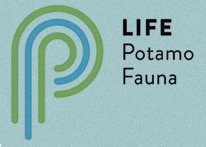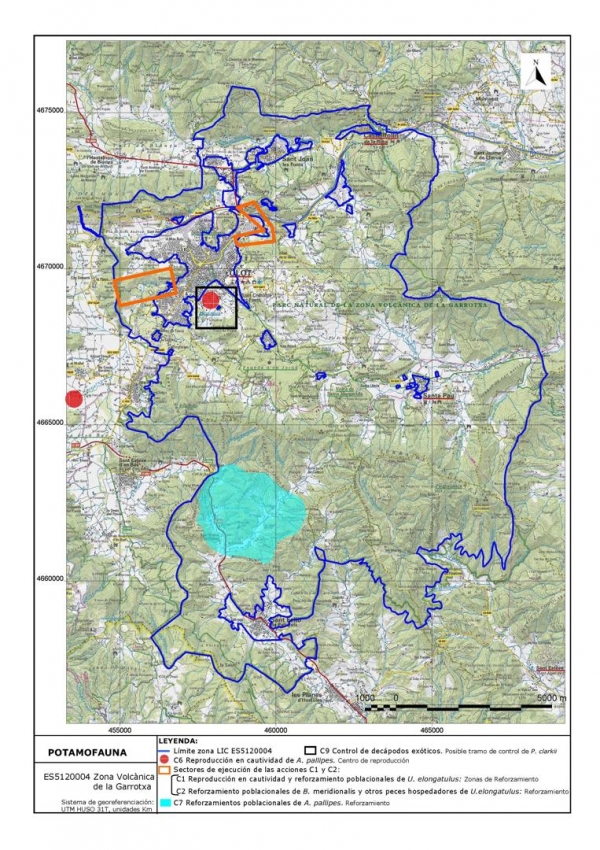Garrotxa Volcanic Zone
Surface: 15.213,700 ha.
The Natura 2000 area of the Garrotxa Volcanic Zone (ES5120004) has been declared a National Park by the Government of Catalonia and includes among its limits 26 natural reserves, essentially volcanoes and beech forests. 96% of the space is included as Area of Outstanding Natural Garrotxa Volcanic Zone in the Plan for Areas of Outstanding Natural Beauty of the Government of Catalonia.
Garrotxa Volcanic Zone comprises an important part of the high basin of the river Fluvià, from 238 meters in the river Fluvià up to 1,026 meters from the summit of Puigsallança, the end of the Serra de Finestres range. Formed by a major volcanic complex, it crosses the mountains from Eocene periode, containing forty Strombolian volcanic cones, explosion craters and more than twenty basaltic lava flows.
The working area of the project does not include the entire SCI. Here the project area focuses only on streams and rivers, involving a very small area centered around these aquatic environments that are found in the target project.
The importance of the populations of the Garrotxa Volcanic Zone of the target species of this project, essentially the Naiad Unio Elongatulus, Mediterranean Barbel (Barbus meridionalis) and White-clawed Crayfish(Austropotamobius pallipes) is remarkable, although difficult to quantify in terms of demography.
The Naiad Unio Elongatulus. Its regression in Catalan basins has been dramatic. The population of this species in the river Fluvià in Garrotxa is one of the few populations that are known to Fluvià basin and in the whole basin of northeastern Catalonia. In the River Fluvià the populations are good in some bypass channels near the mills, and even in the main course. Within the same river basin and near the park is the best populations in the basin, evene outside the boundaries of the Park, but within the limits of the river Fluvià SCI (ES5120021). In this context, the Garrotxa Volcanic Zone Natural Park has devoted much effort to study the population of Unio elongatulus to experiment with reproduction in semi captivity, and to repopulate the river Fluvia within the limits of the Natural Park. For some years, between 2002 and 2011, were tested by naiads infestation of fish larvae and subsequently released to the environment. These actions are difficult to track because it is difficult to verify the success of the repopulation. Actions have been implemented for the recovery of this species within the limits of the Garrotxa Volcanic Zone Natural Park, and also tracked between 2002 and 2011 the population of the river Ser. The presence of Unio in other tributaries of the river Fluvia and Ser, are unknown as well, even though it is fully understood that there is potential habitat for these species.
Actions are planned such as stocking with captive-bred in the breeding naiads laboratory in Consorci de l’Estany, in Banyoles, from parental individuals of the same river basin. Since there may be some genetic differentiation between basins and sub-basins, the units used must proceed from the same parental population (river Ser) within the same watershed. In each of these areas will choose between 2 and 4 sectors where reinforcements will be conducted with youth naiads and infestations of wild fish with naiads. These sectors will be allocated based on information previously available on the general state of the rivers in the area of general scope of the project and the current understanding of the requirements of the species and the status of their populations. Chosen stretches of river with a stable river channel morphology, suitable courses, good water quality, scarce natural hydrological stress, general good ecological status and the presence of at least one species of native fish host, among other criteria.
Mediterranean Barbel (Barbus meridionalis). This species is experiencing a gradual decline in the whole of its small distribution area, located in southern Europe. While still maintaining stable populations in dense areas in some rivers, has disappeared from many sectors, especially along the main river that previously occupied. In the basin of the river Fluvià, Barbus meridionalis has still stable populations in some areas, especially in upstream, such as those included in the NaturalPark, but is generally in decline, having disappeared completely from the middle of the river-bottom.
The recovery actions for Barbus meridionalis in the River Fluvià depends on the relationship with stock recovery Unio elongatulus. In places where it is intended to repopulate with youth Unio elongatulus bred in captivity, studied the composition of fish, to ensure the presence of the guests with naiads Barbus meridionalis, Squalius laietanus or Salaria fluviatilis. In case of not having the presence of these species, repopulation runs occasionaly with Barbus meridionalis.
White-clawed Crayfish(Austropotamobius pallipes). The catalogue of threatened fauna species of Catalonia (pending approval) considered endangered (its short-term survival is unlikely). Wide distribution in Catalonia, but very localized mainly in small creeks and streams undisturbed.
The situation of these species in the VolcanicZoneNaturalPark is delicate, but retains some scattered populations in small rivers and streams. The populations of these species are located on small streams due to natural barrier (drought, cliffs ...) and the crayfish plague -the fungus. has not been reached. Currently populations suffer the threat of the spread of other crayfish. Between 1998 and 2002, and later, censuses were done to know the populations, which are located in several areas of interest that have been the object of special care and conservation.
The precise details about the process of reproduction in captivity of Austropotamobius pallipes is established in the corresponding protocol in accordance with the objectives of this project. One of the factors essential to incorporate this protocol is to maintain breeding lines for each separate area of origin of the parental units. The reinforcements population will be carried out in appropriate sectors of the SCI included in the performance area of the project. In some sectors where the species has disappeared, but always within the SCI which is still present, theses actions will enable the establishment of new populations are at least 1 in every SCI.
Within the space of the GarrotxaVolcanicZoneNaturalPark is running a breeding center crayfish, which is dedicated to the captive breeding of native crayfish in Catalonia. Based in the work and the experience of this center is intended to restock the crayfish in the Park and n other localities of the whole area covered by the project.

















